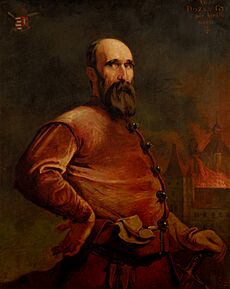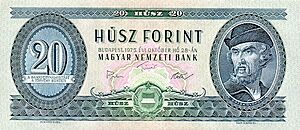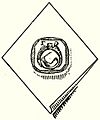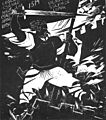György Dózsa facts for kids
Quick facts for kids
György Dózsa
|
|
|---|---|
| Born | 1470 Dálnok, Transylvania, Kingdom of Hungary
|
| Died | 20 July 1514 Temesvár, Transylvania, Kingdom of Hungary
|
| Other names | György Székely, Gheorghe Doja |
| Known for | leader of peasant revolt |
| Relatives | Gergely Dózsa (brother) |
György Dózsa (born around 1470 – died July 20, 1514) was a brave soldier from Transylvania, part of the Kingdom of Hungary. He became famous for leading a big revolt of peasants against the rich landowners and nobles. This happened during the time of King Vladislaus II of Hungary. Sadly, the rebellion was stopped, and Dózsa was caught, tortured, and killed.
Contents
Dózsa's Early Life and Times
György Dózsa was from a group of people called the Székelys. He was probably born around 1470 in a place called Dálnok. We don't know much about his family or childhood. He had a younger brother, Gergely Dózsa, who was also involved in the revolt and died with him.
Dózsa likely didn't go to school much and probably couldn't read or write. He grew up in a time when there were many problems and small rebellions. Peasants often had to pay very high taxes. After King Matthias Corvinus died in 1490, there was a fight for the throne. This caused more trouble in Transylvania. People suffered under harsh rulers who demanded a lot of money and used torture. This led to many small uprisings even before Dózsa's big revolt.
A Brave Soldier and Hero
György Dózsa was known for his bravery in battles against the Ottoman Empire. He was a cavalry captain and fought with great courage. People told stories about him, especially one where he fought a famous Ottoman champion named Ali.
This duel happened on February 28, 1514. Ali was a very skilled swordsman who had defeated many Hungarian fighters. Dózsa, wanting to show Hungarian strength, challenged Ali. In the story, they fought with spears first, then swords. Dózsa managed to cut off Ali's armored hand and then killed him.
Because of this victory, King Vladislaus rewarded Dózsa. He was given a noble title, a village, and a special coat of arms. This made Dózsa famous across the country. He was even knighted by the King and given more money and land.
The Peasant Crusade Begins
In 1513, the new Pope Leo X wanted to drive the Ottomans out of Europe. He announced a crusade and asked Archbishop Tamás Bakócz to organize it. The Pope's message called on ordinary people, not just princes, to join this holy war.
The King and his nobles debated whether this was a good idea. Some worried that taking so many peasants away from their farms during summer harvest would hurt the country's food supply. They also thought untrained farmers wouldn't be good soldiers. But the idea of a peasant crusade won, and the Pope's message was shared.
Gathering the Volunteers
Archbishop Bakócz asked the Franciscan monks to help recruit people. Within two weeks, about 15,000 volunteers gathered near Pest. However, some monks also started talking about unfairness in society. They encouraged peasants to refuse to pay taxes to the king and landlords. They even called for violence against tax collectors.
Many of these volunteers had their own social goals in mind. They wanted things to be fairer. Soon, tensions grew, and there were reports of attacks on noble houses. The situation quickly turned into a widespread uprising.
At first, volunteers joined slowly. Dózsa was chosen to lead the crusade. He had military experience and was liked by the peasants. However, some reports say that Dózsa only took full control when the peasants became violent and unhappy.
Dózsa Leads the Revolt
Within a few weeks, Dózsa had an army of about 40,000 people. Most were peasants, but there were also students, monks, and priests. They were some of the lowest-ranking people in society. They gathered in their home areas, and Dózsa gave them some military training.
The volunteers became very angry because the nobles were not helping to lead the crusade. The nobles were supposed to be the military leaders, but they didn't show up. As harvest time came, landlords told the peasants to go back to work. When they refused, the landlords treated their families badly and sent their own armed men against them.
The Archbishop Bakócz tried to stop the crusade when he heard about fights between peasants and nobles. But György Dózsa, his brother Gergely, and some Franciscan monks refused to stop. They started calling the nobles and the King "traitors" who were secretly helping the Ottomans. The peasant armies then decided they needed to defeat the nobles and the King first, before fighting the Ottomans. The crusade turned into a war of revenge against the landlords.
Key Leaders of the Peasant Army
The peasants didn't trust the nobles, so they chose their own leaders:
- Gergely Dózsa, György's younger brother.
- Laurence Mészáros, a Franciscan priest who promised forgiveness of sins to those who joined the crusade.
- Ambrose Ványa, a Franciscan scholar who helped write Dózsa's powerful messages to the people.
- Anthony Nagy, a nobleman who led the crusaders from Kalocsa.
Goals of the Revolt
Dózsa and his leaders wanted to make big changes to the church and the government. They wanted one elected bishop for the whole country and for all priests to be equal. They also wanted to get rid of the noble class and share the land of nobles and the Church equally among the peasants. They believed there should only be two groups of people: city dwellers (merchants and craftspeople) and peasants. They even wanted to get rid of the king and have the people rule themselves. Dózsa saw himself as a military leader who would follow the people's decisions.
The Franciscan monks, who came from peasant families, helped spread these ideas. With their help, Dózsa warned his peasant soldiers that if they betrayed their "holy crusade" and their "just" social goals, they would face punishment.
The Rebellion Spreads
The rebellion grew more dangerous when towns started joining the peasants. In places like Buda, the cavalry sent to stop them were even pulled off their horses.
The army was not just Hungarians. About 40% were Slovaks, Rusyns, Romanians, and Serbs. There were also a few Germans. As news of Dózsa's first victories spread, peasant riots broke out in many parts of the country, involving people of different nationalities.
The rebellion spread quickly, especially in the central Hungarian areas. Hundreds of noble houses and castles were burned, and many lower-ranking noblemen were killed. Dózsa's camp at Cegléd was the main base for all the attacks in the area.
In response, the Pope's order for the crusade was canceled. King Vladislaus told the peasants to go home or face death. But by then, the uprising had become a full-blown revolution. The King called on all his loyal nobles and hired soldiers from other countries to fight the rebels. Meanwhile, Dózsa captured the city and fortress of Csanád. He showed his victory by hurting the bishop and the castle commander.
Later, at Arad, the Lord Treasurer István Telegdy was captured and killed. However, the rebels usually only killed nobles who were very cruel or greedy. Those who surrendered were often let go. Dózsa himself was known for keeping his promises and sometimes even helped people escape. But he couldn't always control all his followers, and some of them hunted down their rivals.
The End of the Revolt
During the summer, Dózsa captured more fortresses like Arad, Lippa, and Világos. He even got cannons and trained gunners. One of his groups got very close to the capital city. But his peasant army, who were not well-armed, were no match for the nobles' strong cavalry.
Dózsa was eventually defeated at Temesvár (today Timișoara, Romania) by an army of 20,000 led by John Zápolya and Stephen Báthory. He was captured after the battle and executed.
The revolt was stopped, but many peasants were punished. György Dózsa's execution and the harsh treatment of the peasants had a big impact. It made Hungary weaker and less united, which later helped the Ottomans invade in 1526. New laws were made that made life very hard for peasants and gave more power to the lower nobility. This situation lasted until 1848 when serfdom (a system where peasants were tied to the land) was finally ended.
Dózsa's Legacy
Even after his death, György Dózsa's story inspired other peasant uprisings in Hungary. For example, there was a revolt led by Jovan of Czerni just twelve years later, and a peasant uprising in Croatia led by Ambroz Gubec in 1572–1573.
Today, where Dózsa was executed, there is a Virgin Mary Monument. It was built by architect László Székely and sculptor György Kiss. The first statue was put up in 1865, and the current monument in 1906. The Hungarian opera composer Ferenc Erkel even wrote an opera about him called Dózsa György.
During the Communist time in Romania, Dózsa was seen as a revolutionary hero. His story was used to show how people fought against unfair systems. In Budapest, a square, a busy street called Dózsa György út, and a metro station are named after him. His name is also very common for streets in Hungarian villages and in cities in Romania and Serbia. Hungary has even issued postage stamps in his honor.
Images for kids





